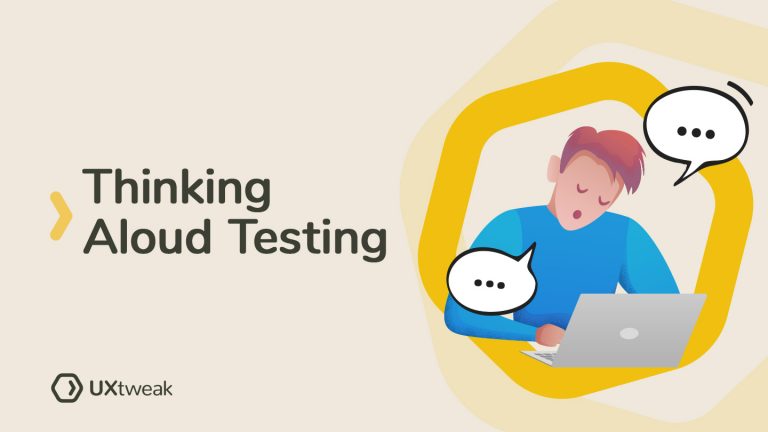User experience is getting more and more important for digital products nowadays. When not accounting for usability testing, your website may seem out of place, order, or even date. With usability testing studies you can ask your users directly about their opinions, and make decisions based on facts.
Today we will be focusing on task-driven usability tests. We will talk about what benefits usability testing and how you can implement it remotely within minutes with our ready-to-go example and a 10-step process to running task-oriented usability studies for your websites, web apps, or prototypes.
Table of contents
- What is task-based usability testing?
- Why you should try task-based usability tests?
- When is the right time to use task-based usability testing?
- How to create a task-based usability test?
- 6 Mistakes to avoid when writing task scenarios for usability testing
- 10-step Usability Testing process
- Are you ready to take your website to the next level?
What is task-based usability testing?
Your customers expect to easily navigate to the products they are looking for effortlessly and find all the information they need. They expect an issue-free experience while using your website. This is where they often get disappointed. As we all know, unclear and broken websites expectedly lead to low conversions, high bounce rates, etc.

Task-oriented usability studies aim to combat this problem. Such studies combine qualitative research methods to provide you with in-depth explanations, and as much context as possible while not forgetting about important quantitative metrics and statistics. They take into account that your users need to accomplish specific goals on your website and they should be able to do so easily.
A task-oriented usability study is built around a real-life task and scenario to simulate the real experience of users and encourage them to interact with your product naturally. Using this method you can test a website’s ability to do what it was built for – satisfying a customer from the user’s point of view and bringing conversions.
The task is simply an action you want your users to be able to complete in your interface. This type of testing can be conducted in person or online with the help of specialized usability testing tools.
Why you should try task-based usability tests?
Every website, web app, and mobile app is built with a goal in mind. For example, the main goal of an e-commerce website is to sell products, additional goals could be to let users subscribe to the newsletter (to sell more products later on and create engagement).
When users get in contact with any problems prohibiting them from completing certain goals they set, it creates a bad brand experience, meaning your customers will be less likely to return to your store and create revenue.

Unfortunately, even the most optimized or well-coded websites don’t get this aspect perfectly, as it is next to impossible to predict the exact way your users will be using your digital products. To battle this problem, you need to observe how your users interact with the interface and features in the context of the real day-to-day experience.
Task-oriented usability testing allows you to qualitatively analyze how your users go about solving the tasks set by you, why users were not able to complete them successfully, or what distracted them during their efforts.
When is the right time to use task-based usability testing?
When you are looking for detailed answers from a larger number of your users to questions such as:
- Why does your e-commerce website have a high abandonment rate at the checkout?
- Why don’t your users sign up for your newsletter?
- What causes low conversions?
- Is your site navigation effective and intuitive?
- Can users find the information they are looking for about your company? etc.
Task-oriented usability study with a Website Testing tool is made exactly to battle this problem and is probably a good place to start. You can learn more in our post about When, Why & How to run usability testing.
Advantages of remote task-based usability testing
- Higher completion rate due to motivation to complete the task by setting relatable scenarios (for example: Subscribe to our newsletter.)
- Testing on real day-to-day tasks that make it relatable to your users
- Realistic results when put into practice correctly
- Actionable insights to improve on
- Less costly than in-person interviews
- Qualitative insights scalable to any number of users
Disadvantages of remote task-oriented usability tests
- Poorly prepared tasks will lead to skewed, even harmful results
- Unrelatable scenarios discourage users from completing tasks
- Possible incorrect identification of goals
- Only makes sense to conduct on high-fidelity prototypes or finished products
How to create a task-based usability test?
Firstly, the most important part of task-oriented usability testing is setting the tasks correctly, so they are relatable to the testers and much easier to interpret. Let’s tackle that first. Here you will find usability testing examples you can use as a stepping stone to creating your first study, making it easier for you to grasp the whole concept.
Example: Usability test for an e-commerce website
Start by setting the goals of your website. In this case, customers have to be able to order products, check and track their orders and get customer support without any difficulties.
Some of the common mistakes e-commerce websites make that put customers off are:
- counter-intuitive filtering and searching for products
- inadequate payment methods
- bad return policy and refunds
- excessive load time of website
- complicated shopping cart
- long delivery time
To make sure you avoid these mistakes, we prepared these 3 sample tasks for you to start testing in no time.
Task 1: Find the least expensive smartphone in our offer and find more details about it.
Task 2: Find out whether it’s possible to use Paypal to pay in our online shop.
Task 3: Find how we can ship your order and which method is the least expensive.

How do you write tasks for usability tests?
When writing tasks for usability tests it’s important to focus on real-life user scenarios and their interactions with your digital product. Define a clear goal of what you’re trying to find out in your usability test and put together a list of usability testing tasks and questions that correspond to those goals.
When you’re conducting your first usability test with the product a great tip is to focus your tasks on some of the most common actions users take with it. You can see that in the example above where we are testing an e-commerce website, the first task asks the user to find a specific product and details about it. Testing that user scenario is a priority for an e-commerce store as their main goal is to get people to find and buy their products.
Follow a short list of guidelines we’ve outlined below to create a perfect usability testing task that lacks bias. Or check our guide to creating usability testing tasks and questions.
Guidelines for writing usability testing tasks
- Create simple realistic tasks – overly complicated tasks will lead to high abandonments
- Set realistic scenarios – to increase relatability and motivation to complete the task
- Task has to encourage a user to carry out an action
- Scenarios must not guide or hint to users on how to complete it – the test will be useless if you tell your testers how to complete it
- Leave out unnecessary pieces of information
As mentioned above, task-oriented usability testing is a powerful method when used correctly, especially in combination with pre and post-study questionnaires, think-aloud protocol, and crowd feedback. So, if you are looking for an option to conduct it remotely look no further. UXtweak Website Testing combines task-oriented usability testing with user session recordings to create the ultimate feature. Before conducting your first test, we recommend writing a usability testing plan to follow to make sure you don’t forget anything.
Lean more about writing effective usability testing tasks in this quick YouTube video:
If you are interested in setting up a Website Testing study you can find a detailed explanation in the Website Testing Setup. On the other hand, below is a quick 10-step guide to starting testing as soon as possible. These are the steps to take.
How to write Task Scenarios for Usability Testing
If you’re looking to conduct a task-based usability study, it’s always good to have a working example to follow when writing tasks for your test. We gathered a couple of those to help you out. Choose the usability testing template that fits your needs.
Let’s take a look at mistakes to avoid while writing tasks that make sense for the users, and engage them enough to carry them through your study without boring them to death. This is very important, since giving them non-engaging tasks may create several problems down the road and may create a study in which results are unusable in further research.
6 Mistakes to avoid when writing task scenarios for usability testing
Getting too personal
It is true that you need to understand the user but be aware of the limitations of your relationship. You are the employer, they are the employee, and you should treat them as such. If you are asking personal questions or setting scenarios involving their loved ones, this could trigger an emotional response in the study participants, resulting in a biased study. Just follow the rule: “Let’s not bring my mother into this.”
❌Bad example of a study question: You want to get a cake done for your mother’s birthday, buy her a cake.
✅Good example of a study question: Get your colleague a present, due to her recent promotion
Using dummy text to convey real information
Of course, when asking for their address or credit card information, use fake information, but make sure it’s realistic. Maybe you asked for their credit card information multiple times during their study, but if they simply used a fake text like “123,” they might not have noticed that you asked this question several times. Rather, when asking for their credit information use “0123 4567 8910 1112” instead.
❌Bad example of a study question: Subscribe to our newsletter, use “aaa” as an email address
✅Good example of a study question: Subscribe to our newsletter, use “jane.dove@foomail.co.uk”

Being overly specific
You should be creating a scenario, not a checklist for the user to pass. Being too specific in these kinds of questions may result in robot-like study results, users have to find the struggle themselves, and you can’t point them in the right direction up front. Try to write your tasks without giving away the solutions.
❌Bad example of a study question: Use the menu to access “Contact,” then click on the button labeled “Contact Us” and send us a message.
✅Good example of a study question: Find a way to send us a message.
Keep it clear and simple
Scenarios need to be believable and need to reflect the situation the users would find themselves in. Let’s not add more information that would overwhelm the user. Just ask the users to do what you need them to do, give a little bit of a perspective, and call it a day.
❌Bad example of a study question: You have been very interested in our newsletter recently because our product is superior to our competitors. Please fill out the form to subscribe to our newsletter.
✅Good example of a study question: You took interest in our newsletter, please subscribe to it.
Using your studies as a marketing tool
While on the topic of keeping to the point. For the love of all that’s holy, try to not bring marketing to your studies. Marketing-speak is a bunch of pretty words with no additional meaning or information. Marketing, which is highly based on emotions, should not be present in your qualitative, or quantitative research. These are two separate entities, and should not be mixed.
❌Bad example of a study question: Take a look at our newest featured product and transcribe its endless possibilities.
✅Good example of a study question: Find the most recent addition to our product line, and repeat the positives stated on the page.
Asking about the future
The future is uncertain, you never know what will happen in the future, you might be rich, broke, or dead. Asking about the future will bring skewed results, therefore ask more about the past, or the present, rather than the future.
❌Bad example of a study question: Would you buy this product?
✅Good example of a study question: Do you have any prior experience with a product similar to ours?
10-step Usability Testing process
- Register to UXtweak.
- Create a new Website Testing Study from the dashboard.
- Set the basic information – the study name, the domain you are going to conduct testing on, whether you want to protect your study by password, etc.
- Integrate UXtweak snippet to your website – use Google Tag Manager for super quick and pain-free implementation. If you are not using GTM (you should start :), it is great!) just copy your snippet into your website code below <head> on every page you wish to record on. Participants can also test your website with a UXtweak Chrome Extension, without any installation to your website, or GTMs.
- Set the start and success URL.
- Create tasks and scenarios – just copy/edit our provided example if you want to start testing in a matter of minutes! If you need to write one yourself take a look at our explanation and guidelines above or visit our blog all about asking the right questions while testing
- Set your options – UXtweak offers a lot more than just measuring task completion. You can find more about your options in Tasks Tab and how to use them here.
- Prepare questionnaires and customize messages – UXtweak comes with already prepared messages and instructions, to save you time. They are fully customizable, so feel free to customize the messages you deem fit.
- Finish the study setup – choose what information you want to collect, add your branding, set up a recruitment widget, and the setup is finished.
- Recruit participants and you are ready to launch the test!

Pro tip: There are many ways to get participants for your study, and some of them are even for free. Check our blog about recruiting participants for free, if you run a tight ship on a tight budget.
Are you ready to take your website to the next level?
We’ve shown you how to set up a study, showed you an example, and listed all the benefits of using website testing. Still not sure about it? Why don’t you try it out for yourself, and see what happens when you listen to your users and adapt according to their needs. As a bonus, with UXtweak you can test for these issues completely free. Register now and don’t miss out on the opportunity to make your website better.





